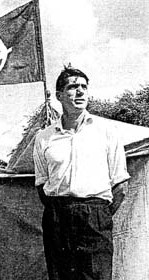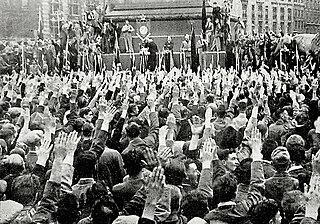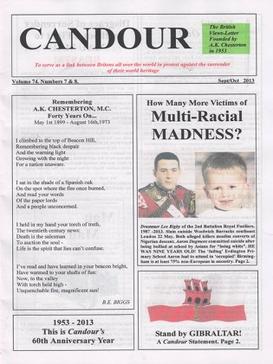
John Hutchyns Tyndall was a British neo-fascist political activist. A leading member of various small neo-Nazi groups during the late 1950s and 1960s, he was chairman of the National Front (NF) from 1972 to 1974 and again from 1975 to 1980, and then chairman of the British National Party (BNP) from 1982 to 1999. He unsuccessfully stood for election to the House of Commons and European Parliament on several occasions.

The National Front (NF) is a far-right, fascist political party in the United Kingdom. It is currently led by Tony Martin. A minor party, it has never had its representatives elected to the British or European Parliaments, although it gained a small number of local councillors through defections and it has had a few of its representatives elected to community councils. Founded in 1967, it reached the height of its electoral support during the mid-1970s, when it was briefly England's fourth-largest party in terms of vote share.

Arthur Kenneth Chesterton was a British journalist and political activist. From 1933 to 1938, he was a member of the British Union of Fascists (BUF). Disillusioned with Oswald Mosley, he left the BUF in 1938. Chesterton established the League of Empire Loyalists in 1954, which merged with a short-lived British National Party in 1967 to become the National Front. He founded and edited the magazine Candour in 1954 as the successor of Truth, of which he had been co-editor.
Column 88 was a neo-Nazi paramilitary organisation based in the United Kingdom. It was formed in the early 1970s, and disbanded in the early 1980s. The members of Column 88 undertook military training under the supervision of a former Royal Marine Commando, and also held regular gatherings attended by neo-Nazis from all over Europe. The name is code: the eighth letter of the alphabet 'HH' represents the Nazi greeting 'Heil Hitler'. Journalist Martin Walker described Column 88 as a "shadow paramilitary Nazi group".

The National Labour Party (NLP) was a British neo-Nazi political party founded in 1957 by John Bean. The party campaigned on a platform of white nationalism, anti-Semitism, and opposition to non-white immigration.

The White Defence League (WDL) was a British neo-Nazi political party. Using the provocative marching techniques popularised by Oswald Mosley, its members included John Tyndall.
John Edward Bean was a British political activist and writer, who was a long-standing participant in far-right politics in the United Kingdom, and a number of its movements.

Andrew Fountaine was an activist involved in the British far right. After military service in a number of conflicts, Fountaine joined the Conservative Party and was selected as a parliamentary candidate until his outspoken views resulted in his being disowned by the party.
The National Party of the United Kingdom (NP) was a short-lived splinter party from the British National Front (NF). It was formed on 6 January 1976, and was dissolved in 1984.
The Greater Britain Movement was a British far right political group formed by John Tyndall in 1964 after he split from Colin Jordan's National Socialist Movement. The name of the group was derived from The Greater Britain, a 1932 book by Oswald Mosley.
The British National Party (BNP) was a neo-Nazi political party in the United Kingdom. It was led by John Bean. The group, which was subject to internal divisions during its brief history, established some areas of local support before helping to form the National Front in 1967. Scholar Nigel Fielding described the BNP as having a "firmly Nazi" ideology.
The National Democratic Party (NDP) was a right wing political party that operated in the United Kingdom during the 1960s and 1970s. The NDP sought to position itself as an early rival to the National Front although ultimately it failed to challenge the position of this group.
The National Socialist Movement (NSM) was a British neo-Nazi group formed on 20 April, Adolf Hitler's birthday, in 1962, by Colin Jordan, with John Tyndall as his deputy as a splinter group from the original British National Party of the 1960s.

Far-right politics are a recurring phenomenon in the United Kingdom since the early 20th century, with the formation of Nazi, fascist and antisemitic movements. One of the earliest examples of fascism in the UK can be found as early as 1923 with the formation of British Fascisti by Rotha Lintorn-Orman. It went on to acquire more explicitly racial connotations, being dominated in the 1960s and 1970s by self-proclaimed white nationalist organisations that opposed non-white and Asian immigration. The idea stems from belief of white supremacy, the belief that white people are superior to all other races and should therefore dominate society. Examples of such groups in the UK are the National Front (NF), the British Movement (BM) and British National Party (BNP), or the British Union of Fascists (BUF). Since the 1980s, the term has mainly been used to describe those groups, such as the English Defence League, who express the wish to preserve what they perceive to be British culture, and those who campaign against the presence of non-indigenous ethnic minorities.
The British People's Party (BPP) was a British far-right political party founded in 1939 and led by ex-British Union of Fascists (BUF) member and Labour Party Member of Parliament John Beckett.
Roy Painter was a former leading figure on the British far right.

Candour is a British far-right political magazine founded by journalist and political activist A. K. Chesterton, appearing weekly from 1953 to 1960, and in to eight to ten issues per year by 1999, and irregularly published as of 2022.
The Racial Preservation Society was a far-right pressure group opposed to immigration and in favour of white nationalism, national preservation and protection in the United Kingdom in the 1960s.
The history of the National Front, a far-right political party in the United Kingdom, began in 1967, when it was founded by A. K. Chesterton.








